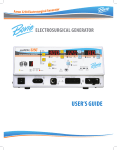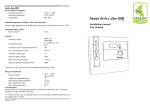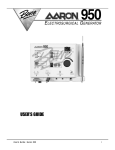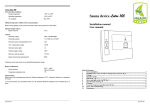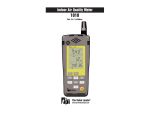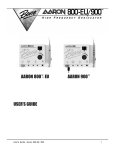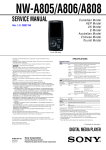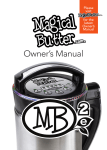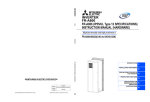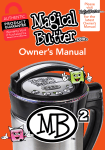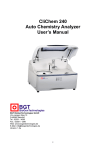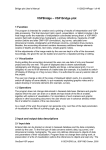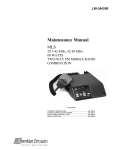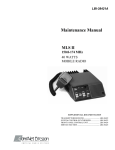Download Aaron 940 User Guide - Bovie Medical Corporation
Transcript
USER’S GUIDE User ’s Guide • Aaron 940™ 1 TABLE OF CONTENTS Introduction..................................................................................................................................................3 Operating Principle ...................................................................................................................................3 Safety...............................................................................................................................................................3 Introduction..................................................................................................................................................3 Warnings and Cautions ............................................................................................................................3 Contraindications .......................................................................................................................................6 Application Specification.........................................................................................................................6 Unit Operation .............................................................................................................................................7 Setup Procedures........................................................................................................................................7 Maintenance.................................................................................................................................................9 Sterilization ...................................................................................................................................................9 Accessories .................................................................................................................................................10 Technical Description .............................................................................................................................10 IEC Classifications.....................................................................................................................................11 EMC Compliance ......................................................................................................................................11 Warranty and Repair ...............................................................................................................................14 Troubleshooting .......................................................................................................................................15 Output Power Characteristics..............................................................................................................16 Graphs ..........................................................................................................................................................17 Descriptions of Symbols........................................................................................................................18 2 Bovie Medical Corporation INTRODUCTION Thank you for purchasing the Aaron 940™. Please visually check the unit to ensure that damage did not occur during shipment and that all standard items are included. The basic unit should include the electrosurgical unit with power cord, a handpiece, 50 disposable sharp dermal tips, 50 disposable blunt dermal tips, and a mounting kit (A837). If there are any discrepancies, please contact Bovie® at +1-727-384-2323. For the latest user information and technical bulletins, visit www.boviemed.com. OPERATING PRINCIPLE The Aaron 940™ High Frequency Desiccator is intended for the removal and destruction of skin lesions and coagulation of tissue. SAFETY The safe and effective use of electrosurgery depends to a large degree on factors solely under the control of the operator. There is no substitute for a properly trained and vigilant medical staff. It is important that they read, understand, and follow the operating instructions supplied with this electrosurgical equipment. Physicians have used electrosurgical equipment safely in numerous procedures. Before starting any surgical procedure, the surgeon should be familiar with the medical literature, complications, and hazards of using electrosurgery in that procedure. To promote the safe use of the Aaron 940™ High Frequency Desiccator, this section presents the warnings and cautions that appear throughout this user’s guide. So that you can operate this equipment with maximum safety, it is important that you read, understand, and follow the instructions in these warnings and cautions. It is also important that you read, understand, and follow the instructions for use in this user’s guide. Emergo Europe Molenstraat 15 2513 BH, The Hague The Netherlands WARNINGS AND CAUTIONS In order to safely operate the Aaron 940™, several precautions need to be followed. WARNINGS: Hazardous Electrical Output - This equipment is for use only by trained, licensed physicians. Danger: Fire / Explosion Hazard - Do not use the Aaron 940™ in the presence of flammable materials. Fire / Explosion Hazard - The following substances will contribute to increased fire and explosion hazards in the operating room: • Flammable substances (such as alcohol based skin prepping agents and tinctures) • Naturally occurring flammable gases which may accumulate in body cavities such as the bowel • Oxygen enriched atmospheres • Oxidizing agents (such as nitrous oxide [N20] atmospheres). The sparking and heating associated with electrosurgery can provide an ignition source. Observe fire precautions at all times. When using electrosurgery in the same room with any of these substances or gases, prevent their accumulation or pooling under surgical drapes, or within the area where electrosurgery is performed. To avoid risk of electric shock, this equipment must only be connected to a supply mains with protective earth. Connect the power cord to a properly polarized and grounded power source with the frequency and voltage characteristics that match those listed on the back of the unit. User ’s Guide • Aaron 940™ 3 WARNINGS: Electric Shock Hazard - Connect the generator power cord to a properly grounded receptacle. Do not use power plug adapters. Electric Shock Hazard - Always turn off and unplug the generator before cleaning. Fire Hazard - Do not use extension cords. No modification of this equipment is allowed. Patient Safety - Use the generator following the directions described in the Setup Procedures. Otherwise, inaccurate power outputs may result. Failure of the high frequency electrosurgical equipment could result in an unintended increase of output power. The instrument receptacles on this generator are designed to accept only one instrument at a time. Do not attempt to connect more than one instrument at a time into a given receptacle. Doing so will cause simultaneous activation of the instruments. Use the lowest output setting necessary to achieve the desired surgical effect. Use the active electrode only for the minimum time necessary in order to lessen the possibility of unintended burn injury. Pediatric applications and/or procedures performed on small anatomic structures may require reduced power settings. The higher the current flow, and the longer the current is applied, the greater the possibility of unintended thermal damage to tissue, especially during use on small structures. Use electrosurgery with caution in the presence of internal or external devices such as pacemakers or pulse generators. Interference produced by the use of electrosurgical devices can cause devices such as pacemakers to enter an asynchronous mode or can block the pacemaker effect entirely. Consult the device manufacturer or hospital Cardiology Department for further information when use of electrosurgical appliances is planned for patients with cardiac pacemakers or other implantable devices. If the patient has an Implantable Cardioverter Defibrillator (ICD), contact the ICD manufacturer for instructions before performing an electrosurgical procedure. Electrosurgery may cause multiple activation of ICDs. Do not use electrosurgical equipment unless properly trained to use it in the specific procedure being undertaken. Use by physicians without such training has resulted in serious, unintended patient injury, including bowel perforation and unintended, irreversible tissue necrosis. For surgical procedures where the high frequency current could flow through parts of the body having a relatively small cross-sectional area, the use of bipolar techniques may be desirable to avoid unwanted coagulation. For all Monopolar modes, any associated equipment and active electrodes must be rated to with stand the combination of output voltage, vp-p and crest factor as stated in this manual. In some circumstances, potential exists for alternate site burns at points of skin contact (e.g., between the arm and the side of the body). This occurs when electrosurgical current seeks a path to the return electrode that includes the skin-to-skin contact point. Current passing through small skin-to-skin contact points is concentrated and may cause a burn. This is true for grounded, ground referenced, and isolated output generators. To reduce the potential for alternate site burns, do one or more of the following: • Avoid skin-to-skin contact points, such as fingers touching leg, when positioning the patient. • Place 5 to 8 cm (2 to 3 in.) of dry gauze between contact points to ensure that contact does not occur. • Position the return electrode to provide a direct current route between the surgical site and the return electrode which avoids skin-to-skin contact areas. • In addition, place patient return electrodes according to the manufacturer’s instructions. Potential for alternate site burns increases if the return electrode is compromised. Bovie recommends the use of split return electrodes and Bovie generators with a contact quality monitoring system. Minor neuromuscular stimulation is possible when arcs between the ACTIVE ELECTRODE and tissue occur. The generator has been designed to minimize the possibility of neuromuscular stimulation. 4 Bovie Medical Corporation The entire area of the neutral electrode should be reliably attached to the patient’s body and as close to the operating field as possible. The cables to surgical electrodes should be positioned in such a way that contact with the patient or other leads is avoided. Temporarily unused active electrodes should be stored so that they are isolated from the patient. Do not wrap the accessory cords or return electrode cords around metal objects. This may induce currents that could lead to shocks, fires, or injury to the patient or surgical team. The use of flammable anesthetics or oxidizing gases such as nitrous oxide (N2O) and oxygen should be avoided if a surgical procedure is carried out in the region of the thorax or the head, unless these agents are sucked away. Non-flammable agents should be used for cleaning and disinfection wherever possible. Flammable agents used for cleaning or disinfecting, or as solvents of adhesives, should be allowed to evaporate before the application if HF surgery. There is a risk of pooling flammable solutions under the patient or in body depressions such as the umbilicus, and in body cavities such as the vagina. Any fluids pooled in these areas should be mopped up before HF surgical equipment is used. Attention should be called to the danger of ignition of endogenous gases. Some materials, for example cotton, wool and gauze, when saturated with oxygen may be ignited by sparks produced in Normal Use of the HF surgical equipment. CAUTIONS: At no time should you touch the active electrode or bipolar forceps. A burn could result. Do not stack equipment on top of the generator or place the generator on top of electrical equipment. These configurations are unstable and/or do not allow adequate cooling. Provide as much distance as possible between the electrosurgical generator and other electronic equipment (such as monitors). An activated electrosurgical generator may cause interference with them. Non-function of the generator may cause interruption of surgery. A backup generator should be available for use. Do not turn the activation tone down to an inaudible level. The activation tone alerts the surgical team when an accessory is active. When using a smoke evacuator in conjunction with the electrosurgical generator, place the smoke evacuator a distance from the generator and set the generator volume control at a level that ensures that the activation tones can be heard. The use of high frequency current can interfere with the function of other electromagnetic equipment. When high frequency surgical equipment and physiological monitoring equipment are used simultaneously on the same patient, place any monitoring electrodes as far as possible from the surgical electrodes. Monitoring systems incorporating high frequency current-limiting devices are recommended. Do not use needles as monitoring electrodes during electrosurgical procedures. Inadvertent electrosurgical burns may result. To avoid the possibility of an electrosurgical burn to either the patient or the physicians, do not allow the patient to come in contact with a grounded metal object during activation. When activating the unit, do not allow direct skin contact between the patient and the physician. The patient should not come in contact with metal parts which are earthed or which have an appreciable capacitance to earth (for example operating table supports, etc.). The use of antistatic sheeting is recommended for this purpose. Remove any loose fitting jewelry from the patient before activation. Examine all accessories and connections to the electrosurgical generator before use. Ensure that the accessories function as intended. Improper connection may result in arcs, sparks, accessory malfunction, or unintended surgical effects. Accessories must be connected to the proper receptacle type. In particular, bipolar accessories must be connected to the Bipolar Instrument output jack only. Improper connection may result in inadvertent generator activation. User ’s Guide • Aaron 940™ 5 CAUTIONS: When not using active accessories, place them in a holster or in a clean, dry, non-conductive, and highly visible area not in contact with the patient. Inadvertent contact with the patient may result in burns. Avoid HF output settings where maximum output voltage may exceed rated accessory voltage. Refer to the accessory’s voltage rating. To avoid incompatibility and unsafe operation, use suitable cables, accessories, active and neutral electrodes, including values for the highest allowed H.F. peak voltage. The output power selected should be as low as possible for the intended purpose. Certain devices or accessories may present a safety hazard at low power settings. Apparent low output or failure of the Aaron 940™ to function correctly at the normal operating settings may indicate faulty application of the neutral electrode or poor contact in its connections. In this case, the application of the neutral electrode and its connections should be checked before selecting a higher output power. When using Monopolar mode, associated equipment and active accessories should be selected that have a voltage rating of 8.0 kV pp or greater. When using Bipolar mode, associated equipment and active accessories should be selected that have a voltage rating of 2.5 kV pp or greater. Studies have shown that smoke generated during electrosurgical procedures can be potentially harmful to patients and the surgical team. These studies recommend adequately ventilating the smoke by using a surgical smoke evacuator or other means.1 1. U.S. Department of Health and Human Services. National Institute for Occupational Safety and Health (NIOSH). Control of Smoke from Laser / Electric Surgical Procedures. HAZARD CONTROLS, Publication No. 96-128, September, 1996. CONTRAINDICATIONS There are no known contraindications. NOTICES: If required by local codes, connect the generator to the hospital equalization connector with an equipotential cable. Do not clean the generator with abrasive cleaning or disinfectant compounds, solvents, or other materials that could scratch the panels or damage the generator. APPLICATION SPECIFICATION Description • A 40 Watt RF desiccator used to coagulate tissue using RF waveform. • Power setting is selectable by front panel manipulation of a rotary encoder knob. • Power and activation are indicated on the unit display. Medical Purpose / Indication • Intended for the removal and destruction of skin lesions and coagulation of tissue, Site Condition • Clean and protect from infection from start through completion of procedure Patient Population – * Patient should not be user. • Age: Infant to geriatric • Weight: > 2.5kg • Patient State: Alert, relaxed, may be sedated, having had local anesthetic applied. 6 Bovie Medical Corporation Intended User Profile • Education – Trained physician, physician’s assistant, nurse, nurse practitioner. No maximum • Knowledge: - Minimum: - Understands electrosurgery and electrosurgical techniques; - Read and understands supplied User’s Guide (Accompanying Document) - Understands hygiene - Maximum: - There is no maximum • Language Understanding – Languages are as specified in the marketing distribution plan • Experience: - Minimum: - Some training on techniques or training under surveillance/supervision - No special experience needed - Maximum: - There is no maximum - Permissible Impairments: - Mild reading / vision impairment or vision correction to 20/20 - Partial hearing impairment, allowing for audible detection of tones at 0.5-2.0 kHz. UNIT OPERATION The Aaron 940™ produces radio frequency current which is useful for the removal and destruction of superficial cutaneous and mucosal lesions. This is done by performing desiccation and fulguration procedures. Electrosurgical desiccation occurs when the electrode is placed directly onto the surface of the lesion. Fulguration occurs when the electrode is held slightly above the lesion and an arc is delivered to the lesion. The unit also provides fast and efficient bleeding control by coagulation of capillaries and small blood vessels. For the majority of desiccation, fulguration, and coagulation procedures utilizing the standard handpiece in the monopolar output, the patient plate is optional. When used, the patient plate will intensify the coagulation properties of the unit and also lessen the opportunity for an electrosurgical burn. The optional footswitch adds versatility when using the standard handpiece in the monopolar output, as the footswitch allows you to activate the unit by either the handpiece or the footswitch. Bipolar outputs are available for those physicians who prefer to utilize bipolar forceps to perform coagulation procedures. A footswitch is required when using the bipolar output and the patient plate is not used. Procedures that are performed in sensitive areas may require an anesthetic. Flammable anesthetics should not be used. If you are unfamiliar with the operation of a low powered electrosurgery unit, it is advisable to practice on chicken or lean flank steak to visualize the effects at various output and power levels. SETUP PROCEDURES 1. Mount the Aaron 940™ on the wall or optional mobile stand using the standard mounting kit (see figure 1). Do not operate the unit in the horizontal position, as liquids may spill into unit. 2. Plug the female end of the power cord into the base of the unit (see figure 2, letter A). 3. Plug the male end of the power cord into a grounded wall receptacle. 4. Plug the handpiece into the monopolar output on the lower left of the front on the unit (see figure 2, letter B). The plug is designed to fit in only one direction. Plug the smaller round connector from the handpiece into the receptacle on the bottom of the unit (see figure 2, letter B). The three button handpiece is designed to give the doctor complete fingertip control of the power output settings. User ’s Guide • Aaron 940™ 7 Figure 1 5. Slide the standard electrode into the handpiece until it is firmly seated (see figure 2, letter C). The handpiece will accept most standard 3/32" electrodes. Figure 2 6. Slide the handpiece from above into the holder on the right side of the unit. 7. Turn the unit power on utilizing the switch on the right side panel of the unit (see figure 2, letter D). 8. Set the power output either by using the dial on the front of the unit (see figure 2, letter E) or on Aaron 940™ unit only by the up and down buttons on the handpiece (see figure 2, letter J). When power level adjustment is being made by the handpiece an audible tone will sound to indicate that the power level has been changed. Depressing and holding the up or down buttons will cause the power settings to change more rapidly for quick 8 Bovie Medical Corporation adjustment of the output settings. Power output is displayed in “.1” watt increments below 10 watts and in whole numbers from 10 to 40 watts. NOTICE: The output settings can not be adjusted when the unit is being activated. 9. To activate the unit, remove the handpiece from the holder. Place the handpiece in the desired position and depress the activation button (see figure 2, letter K). When the unit is activated, an audible tone is sounded and the blue active light will illuminate (see figure 2, letter F). 10. To use the optional grounding plate with cord (A802EU), insert the plug of the cord into the grounding plate output (see figure 2, letter G) and connect the other end into the grounding plate. The plate should be placed underneath the patient at a point where the entire plate is covered by bare skin. 11. To use the optional bipolar cord (A827BP), insert the plugs into the bipolar outputs (see figure 2, letter H). The cord is then plugged into the forceps. A sliding gate behind the monopolar and bipolar outputs prevents the user from using both simultaneously. 12. The optional footswitch (A803) is plugged into the footswitch output and placed on the floor (see figure 2, letter I). The footswitch can be used with monopolar procedures and must be used with bipolar procedures. 13. When the procedure is completed, turn the unit off utilizing the switch on the right side panel of the unit. 14. Return the handpiece to the holder on the right side of the unit and remove the electrode. The electrode should be disposed of after each procedure. If contamination has occurred to the handpiece, the handpiece should also be sterilized. 15. Adjustment of the audible tone is achieved by a switch located on the rear of the unit (see figure 3). Two tone choices are available, high and low. A small screwdriver will be necessary to make the adjustment. Figure 3 850 mA~ MAINTENANCE The Aaron 940™ requires periodic cleaning. When the unit case requires cleaning, simply utilize a soap and water solution and wipe clean. Be careful to not have any water enter into the unit through the various openings. Dry the unit with a clean, lint-free cloth. STERILIZATION The Aaron 940™ and standard accessories are supplied non-sterile. The handpiece may be cleaned and sterilized. Refer to the instruction sheet that accompanies the electrode and handpiece for specific instructions on cleaning and sterilization. We recommend that all contaminated electrodes and handpieces be sterilized prior to disposal. User ’s Guide • Aaron 940™ 9 ACCESSORIES The accessories listed below are original Bovie® accessories to be used with the Aaron 940™. Accessories, replacement parts, and disposable items that are not listed should only be used when their safety and technical suitability have been checked. Additional accessories are available from your local Bovie® dealer. Reusable items must be checked for damage before each re-sterilization. Accidental burns can be caused by damaged accessories. Recommended, Standard Accessories Catalog # Description A901 Replaceable 3-button Handpiece A802EU Grounding Plate with Cord A827BP Reusable Bipolar Cord A804 Disposable Dermal Tips (Sharp) A806 Disposable Dermal Tips (Blunt) 09-005-001 110 VAC Hospital-grade power cord (replacement part) 09-009-001 220 VAC Hospital-grade power cord (replacement part) TECHNICAL DESCRIPTION Mains Connection Main Voltage: Main Frequency: Main Current: Power Consumption: Duty Cycle: Main Fuses: 100 – 240 VAC ± 10% 50 – 60 Hertz 1.00A Max. 75 VA 10sec on / 30sec off T1.0AL250V Safety Basic Construction: Mode of Operation: Protection Class: Output Type: In accordance with EN 60601-1 Intermittent operation CLASS I EQUIPMENT TYPE BF Dimensions and Weight Length x Width x Height = 9" x 4.5" x 6.3" Weight: <5 lbs. 10 Bovie Medical Corporation IEC CLASSIFICATIONS IEC 60601-1 Degree of protection against ingress of water – Ordinary Equipment IEC 60601-1 Equipment not suitable for use in the presence of flammable mixtures. EMC COMPLIANCE The precautions regarding EMC and needs to be installed and put into service according to the EMC information provided in this manual. Understand that only the Accessories supplied with or ordered from Bovie Medical should be used with your device. The use of Accessories, transducers, and cables other than those specified, may result in increased Emissions or decreased Immunity of the Aaron 940™. The Aaron 940™ and its accessories are not suitable for interconnection with other equipment. Portable and mobile RF communications equipment can affect Medical Electrical Equipment. The Aaron 940™ should not be used adjacent to or stacked with other equipment and that if adjacent or stacked use is necessary, the Aaron 940™ should be observed to verify normal operation in the configuration in which it will be used. User ’s Guide • Aaron 940™ 11 Recommended separation distances between portable and mobile RF communications equipment and the Aaron 940™. The Aaron 940 is intended for use in an electromagnetic environment in which radiated RF disturbances are controlled. The customer or the user of the Aaron 940™ can help prevent electromagnetic interference by maintaining a minimum distance between portable and mobile RF communications equipment (transmitters) and the Aaron 940™ as recommended below, according to the maximum output power of the communications equipment. Rated maximum output power of transmitter Separation distance according to frequency of transmitter in metres (m) W 150 kHz to 80 MHz d = 1.2 P 80 MHz to 800 MHz d = 1.2 P 800 MHz to 2.5 GHz d = 2.3 P 0.01 0.12 0.12 0.23 0.1 0.38 0.38 0.73 1 1.2 1.2 2.3 10 3.8 3.8 7.3 100 12 12 23 For transmitters rated at a maximum output power not listed above, the recommended separation distance d in metres (m) can be estimated using the equation applicable to the frequency of the transmitter, where P is the maximum output power rating of the transmitter in watts (W) according to the transmitter manufacturer. NOTE 1 At 80 MHz and 800 MHz, the separation distance for the higher frequency range applies. NOTE 2 These guidelines may not apply in all situations. Electromagnetic propagation is affected by absorption and reflection from structures, objects and people. Guidance and manufacturer’s declaration – electromagnetic emissions The Aaron 940™ is intended for use in the electromagnetic environment listed below. The customer or the user of the Aaron 940™ should assure that is used in such an environment. Emissions test 12 Compliance RF Emissions CISPR 11 Group 2 RF Emissions CISPR 11 Class A Harmonic emissions IEC 61000-3-2 Class A Voltage fluctuations/flicker emissions IEC 61000-3-3 Complies Electromagnetic environment - guidance The Aaron 940™ must emit electromagnetic energy in order to perform its intended function. Nearby electronic equipment may be affected. The Aaron 940™ is suitable for use in all establishments other than domestic and those directly connected to the public low-voltage power supply network that supplies buildings used in domestic purposes. Bovie Medical Corporation Guidance and manufacturer’s declaration – electromagnetic immunity The Aaron 940™ is intended for use in the electromagnetic environment listed below. The customer or the user of the Aaron 940 should assure that it is used in such an environment. IEC 60601 test level Immunity test Electrostatic discharge (ESD) IEC ±6 kV contact 61000-4-2 ±8 kV air Compliance level ±6 kV contact ±8 kV air Electromagnetic environment - guidance Floors should be wood, concrete or ceramic tile. If floors are covered with synthetic material, the relative humidity should be at least 30%. Electrical fast transient/burst IEC 61000-4-4 ±2 kV for power supply lines ±1 kV for input/output lines Surge IEC 61000-4-5 Mains power quality should be that of a ±1 kV differential ±1 kV differential mode typical commercial or hospital mode ±2 kV common environment. ±2 kV common mode Voltage dips, short interruptions and voltage variations on power supply input lines IEC 61000-4-11 Power frequency (50/60 Hz) magnetic field IEC 61000-4-8 ±2 kV for power supply Mains power quality should be that of a lines typical commercial or hospital environment. Not Applicable <5 % Ut (>95 % dip in Ut ) for 0.5 cycle <5 % Ut (>95 % dip in Ut ) for 0.5 cycle 40 % Ut (60 % dip in Ut ) for 5 cycles 40 % Ut (60 % dip in Ut ) for 5 cycles 70 % Ut (30 % dip in Ut ) for 25 cycles 70 % Ut (30 % dip in Ut ) for 25 cycles <5 % Ut (>95 % dip in Ut ) for 5 sec <5 % Ut (>95 % dip in Ut ) for 5 sec 3 A/m 3 A/m Mains power quality should be that of a typical commercial or hospital environment. If the user of the Aaron 940 requires continued operation during power mains interruptions, it is recommended that the Aaron 940 be powered from an uninterruptible power supply or a battery. Power frequency magnetic fields should be at levels characteristic of a typical location in a typical commercial or hospital environment. NOTE Ut is the a.c. mains voltage prior to application of the test level. User ’s Guide • Aaron 940™ 13 Guidance and manufacturer’s declaration – electromagnetic immunity continued... Immunity test Conducted RF IEC 61000-4-6 IEC 60601 test level 3 Vrms 150 kHz to 80 MHz Compliance level 3 Vrms (V1) Electromagnetic environment - guidance Portable and mobile RF communications equipment should be used no closer to any part of the Aaron 940, including cables, than the recommended separation distance calculated from the equation applicable to the frequency of the transmitter. Recommended separation distance d = [ 3.5] P 3 d = [ 3.5] P 3 80 MHz to 800 MHz d= [ 7] 3 Radiated RF IEC 61000-4-3 3 V/m 80 MHz to 2.5 GHz 3 V/m (E1) P 800 MHz to 2.5 GHz where P is the maximum output power rating of the transmitter in watts (W) according to the transmitter manufacturer and d is the recommended separation distance in metres (m) Field strengths from fixed RF transmitters, as determined by an electromagnetic site survey,a should be less than the compliance level in each frequency range.b Interference may occur in the vicinity of equipment marked with the following symbol. NOTE 1 At 80 MHz and 800 MHz, the separation distance for the higher frequency range applies. NOTE 2 These guidelines may not apply in all situations. Electromagnetic propagation is absorption and reflection from structures, objects and people. affected by a Field strengths from fixed transmitters, such as base stations for radio (cellular/cordless) telephones and land mobile radios, amateur radio, AM and FM radio broadcast and TV broadcast cannot be predicated theoretically with accuracy. To assess the electromagnetic environment due to fixed RF transmitters, an electromagnetic site survey should be considered. If the measured field strength in the location which the Aaron 940 is used exceeds the applicable RF compliance level above, the Aaron 940 should be observed to verify normal operation. If abnormal performance is observed, additional measures may be necessary, such as reorienting or relocating the Aaron 940™. b Over the frequency range 150 kHz to 80 MHz, field strengths should be less than [3] V/m. WARRANTY AND REPAIR The Aaron 940™ is covered under warranty for a period of two years. The handpiece is covered under warranty for a period of one year or 25 steam autoclave cycles, whichever comes first. The warranty becomes null and void if damage occurs from incorrect handling or misuse of the product. For warranty and repair work, please contact Bovie® and obtain a Return Goods Authorization number (RGA). Place the number so that it can be seen on the exterior of the package and ship directly to Bovie® . A return without an RGA may not be accepted. 14 Bovie Medical Corporation TROUBLESHOOTING The Aaron 940™ has been designed and manufactured with the utmost safety in mind. The unit is equipped to automatically detect a malfunction. The following table list error codes, their meaning and recommended actions to be taken to resolve the error. Error Code Description of Error Recommended Action E1 Activation upon power up • Check handpiece for activation. • Check footswitch for activation; once the activation is halted the unit will resolve the error. If the error persists the handpiece could be malfunctioning and may need to be replaced. E2 DC Supply Over Voltage Detection • Switch unit off and on again. • Make sure unit is connected to correct power source for the unit. E3 Pulse Width • Switch unit off and on again. E4 Delta Error • Switch unit off and on again. E5 Temperature Error • Switch unit off. Allow unit to cool. Switch unit on. E6 Multiple Errors • Switch unit off and on again. If problems persist, the unit should be taken out of service and the manufacturer should be notified. For technical support or return authorization phone +1-800-537-2790. Operating Parameters Ambient temperature range 10° to 40° C Relative humidity 30% to 75%, non-condensing Atmospheric pressure 70kPa to 106kPa Warm-up time If transported or stored at temperatures outside the operating temperature range, allow one hour for the generator to reach room temperature before use. Transport Ambient temperature range -40˚ to +70˚ C Relative humidity 10% to 100%, including condensation Atmospheric pressure 50kPa to 106kPa Storage Ambient temperature range 10˚ to 30˚ C Relative humidity 10% to 75%, non-condensing Atmospheric pressure 70kPa to 106kPa Warm-up time: If transported or stored at temperatures outside the operating temperature range, allow one hour for the generator to reach room temperature before use. User ’s Guide • Aaron 940™ 15 OUTPUT POWER CHARACTERISTICS Power readouts agree with actual power into rated load to within 20% or 5 watts, whichever is greater. Mode Output Power Coagulation 40 W @ 1000 Ω Bipolar 16 40 W @ 200 Ω Output Frequency Repetition Rate Crest Factor @ Rated Load Vp-p max 550 kHz ± 44.9 kHz 21 kHz ± 10% 9.0 ± 20% 8.0 kV 550 kHz ± 44.9 kHz 21 kHz ± 10% 10.0 ± 20% 2.5 kV Bovie Medical Corporation GRAPHS Figure 4 illustrates output power delivered to rated load for all available modes at selected power settings. Figure 5 illustrates power settings versus Vpeak voltage for all available modes. Figures 6 and 8 illustrate output power load curves. Figures 7 and 9 are the output waveforms as viewed on an oscilloscope. Figure 4 Output power versus power setting for all modes Figure 6 Output Power versus Load • Bipolar 100% / 50% Figure 5 Power setting versus voltage (Vpeak) for all modes Figure 7 Bipolar Mode Waveform Figure 9 Monopolar Mode Waveform Bipolar 100% 50% Figure 8 Output Power versus Load • Monopolar 100% / 50% Monopolar 100% 50% User ’s Guide • Aaron 940™ 17 DESCRIPTION OF SYMBOLS Warning: Dangerous voltage. Caution: Read directions for use prior to using equipment. On (power: connection to the mains). Off (power: disconnection from the mains). Do not dispose of this device in the unsorted municipal waste stream. Monopolar output jack (hand control pencil jack). Bipolar output jack. Patient Plate, for use with Monopolar modes. Footswitch jack, for foot controlled activation of monopolar (optional) and bipolar devices. Type BF Equipment. Non-ionizing radiation. Neutral Electrode referenced to earth. Volume control. Explosion Risk if used with flammable anesthetics. Manufacturer Mandatory: Refer to instruction manual / guide 18 Bovie Medical Corporation 2013-08-09
























